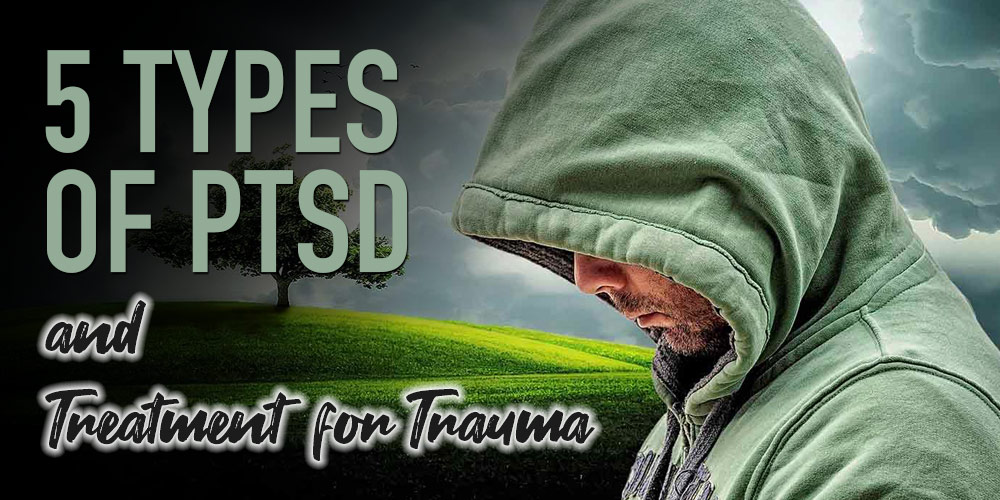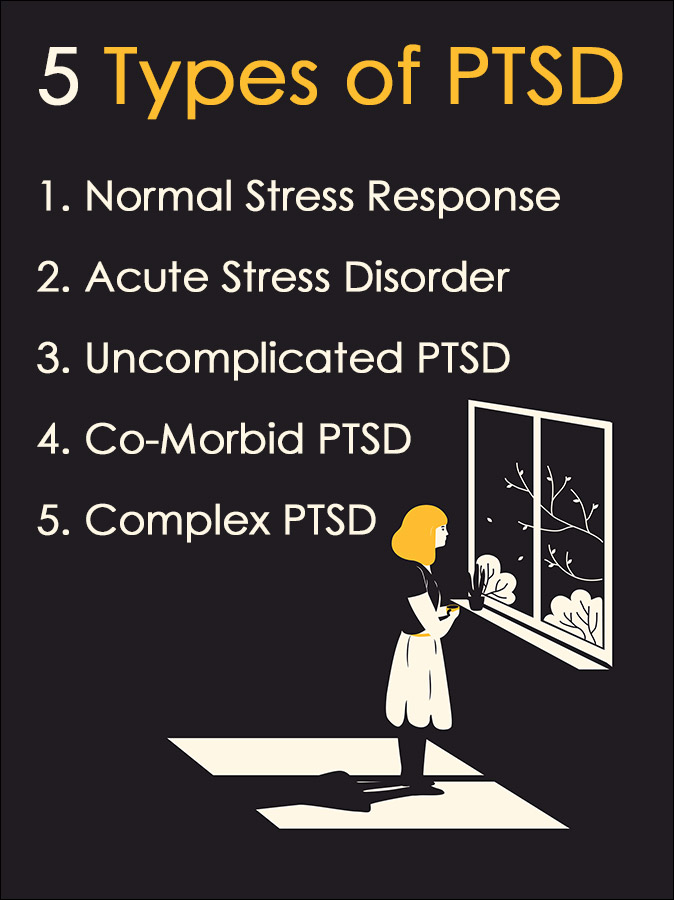
In the last several decades, it’s become clear to health care experts that anyone can suffer from post-traumatic stress disorder, and properly diagnosing one of the 5 types of PTSD will form the basis for successfully treating the condition.
PTSD is often brought on by experiencing or witnessing a traumatic event, such as rape, sexual assault, the threat of death, severe accident, or even a natural disaster among other stressors. If left untreated, post-traumatic stress disorder can be incredibly debilitating.
While scientists continue to research the exact cause of PTSD, there is evidence that for some people, their initial stress response to trauma often triggers a biological “fight or flight” reaction. This can be so overwhelming for some that going back to “normal” is extremely difficult.
There are however, five variations in our stress responses, so understanding what they are can lead to better treatment approaches and recovery outcomes for people struggling with PTSD.
What Are 5 Types of PTSD?
The National Alliance on Mental Illness (NAMI) reports an estimated 9 million adults suffer from PTSD in the United States, with about 37 percent of those coping with serious disorder-related symptoms.
The five types of post-traumatic stress disorder include the following:
1. Normal Stress Response
A Normal Stress Response is exactly as it sounds – this is a normal stress reaction to trauma before the onset of PTSD.
Everyone has a stress response to trauma and human tragedies like the loss of a loved one, chronic illness, or serious injury. With this response, most people will grieve and return to normal with the support of friends and loved ones over the course of several weeks or months.
Individual counseling or group therapy is often recommended, even with a normal stress response, as a way for people to get more perspective and support for what they’re dealing with.

2. Acute Stress Disorder
While not considered full-blown PTSD, an Acute Stress Disorder often develops after exposure to what was or felt like a life-threatening event.
Natural disasters, serious accidents, or near death experiences are just a few examples that can bring about this disorder. Left untreated, acute stress can escalate and become PTSD.
Acute Stress Disorder generally requires a more rigorous treatment approach, including individual and group counseling. A psychiatrist may also prescribe medication to reduce the symptoms of anxiety and depression.
3. Uncomplicated PTSD
The reason the category of Uncomplicated PTSD uses the world “uncomplicated” is because this type of PTSD is connected to one specific traumatic event, as opposed to ongoing trauma or growing up in a chronically distressing environment, like a war-torn area or a physically or sexually abusive home.
Uncomplicated PTSD includes painful symptoms like flashbacks, nightmares, avoidance of trauma triggers, mood changes, and depression. Treatment is likely to consist of a combination of therapy and medication.
4. Complex PTSD
Complex PTSD is the opposite of uncomplicated PTSD, and this type of stress response is linked to multiple or ongoing traumatic events.
Domestic abuse, living with community violence, or repeated exposure to war are just a few examples of what causes complex PTSD. Here, the symptoms are the same as Uncomplicated PTSD, but there is a web of trauma to get through.
People struggling with this condition may have also developed personality or dissociative disorders because of their experiences. Substance abuse, aggression, behavioral and emotional issues are also common.
5. Comorbid PTSD
Sometimes referred to as a co-occurring disorder or dual-diagnosis, Comorbid PTSD is the presence of PTSD with another mental health condition, such as a substance use disorder.
Symptoms of each disorder only complicate and worsen the symptoms of both conditions. This type of PTSD is incredibly common.
The U.S. Department of Veteran Affairs estimates that nearly 50 percent of those with lifetime PTSD also struggle with addiction or a substance use disorder.
Related: Who Are Some Famous People With PTSD?

Ways of Treating 5 Types of PTSD
Getting the right treatment for the 5 types of PTSD can be critical. If a person is diagnosed with uncomplicated PTSD, but is actually dealing with a comorbid condition, it is likely that one or both of their disorders will continue to cause problematic symptoms. This is especially true when treating a dual diagnosis of PTSD and addiction.
Abusing alcohol or drugs may numb some of the symptoms of PTSD, but it will magnify them over time and make them worse.
In and of itself, PTSD can interfere with a person’s impulse control, decision making, and memory functions, making it difficult for them to understand the connection between substance abuse and continued PTSD symptoms.
Thus, treating both individually during the same course of treatment is recommended.
There are a number of effective treatment options for people seeking help for their condition. They include some of the following therapies:
Eye Movement Desensitization And Reprocessing (EMDR)
Eye Movement Desensitization and Reprocessing (EMDR) is a form of psychotherapy that was developed to treat adults struggling with PTSD. It focuses on the disturbing memories as the cause of psychopathology, with the goal of alleviating different types of post-traumatic stress disorder symptoms.
Cognitive Behavioral Therapy (CBT)
Cognitive Behavioral Therapy (CBT) is one of the most popular forms of therapy for a variety of conditions and it analyzes the relationship or connection between thoughts, emotions, and behaviors. CBT teaches coping skills for managing difficult emotions and negative behaviors.
TMS Therapy
TMS Therapy, also known as Transcranial Magnetic Stimulation, is a fairly new treatment method that is FDA approved for treatment-resistant depression but is sometimes used off-label for treating PTSD. It is a painless, and non-invasive outpatient therapy that uses magnetic pulses to stimulate areas of the brain associated with mood.
Equine Therapy
Equine Therapy, or Equine-Assisted Therapy, has shown to be healing and therapeutic for many different types of mental health conditions. It reaches patients on an emotional level and works well for grounding the mind and putting a person at peace.
Neurofeedback Therapy
Neurofeedback Therapy is a form of Neurotherapy that is also known as EEG Biofeedback because it measures and analyzes brainwave activity and offers real-time feedback. It helps train the brain to be more in control of anxiety, depression, and even PTSD symptoms.
Seeking Safety
Seeking Safety is an evidence-based treatment modality to reduce trauma symptoms or substance abuse and teaches coping skills for managing PTSD and addiction.
Prescription Medications
Sometimes prescription medications are helpful for treating PTSD and the FDA has approved Zoloft and Paxil for specific treatment. Other medications might be used off-label to manage the symptoms of depression or other conditions that coexist with PTSD.
MDMA Assisted Psychotherapy for PTSD
MDMA Assisted Psychotherapy for PTSD is one of the newest treatment methods, though it has not yet been fully approved by the FDA. But it has been granted a breakthrough designation so it can be studied for safety and efficacy.
MDMA is not a medication to treat PTSD. Instead, it is used as a mechanism for facilitating psychotherapy, with the goal of decreasing activity in the amygdala and to help people more effectively process their trauma.
Post-Traumatic Stress and the 5 Types of PTSD
Post-Traumatic Stress can overwhelm a person’s ability to cope with or even acknowledge what has happened to them. The consequences of untreated Acute Stress Disorder or any of the 5 types of PTSD can last a lifetime and make it difficult not just for the person living with trauma, but for those that love them as well.
Although it may be difficult to suggest to a loved one or to seek out treatment personally, professional treatment trauma healing exists to identify trauma disorders and help people develop and complete an effective approach for recovery.
There’s no shame in asking for help and overcoming the stigma attached to mental health issues is necessary for successful recovery.
As shown above, there are many different ways of treating the five types of PTSD and a thorough assessment when beginning treatment will identify the best methods for each person’s individual needs.
Related Posts
- Psilocybin Therapy for Depression Treatment and Mental Health
The push to find new and effective treatment approaches for mental health issues like Psilocybin…
- Somatic Experiencing Therapy for Trauma Healing
Trauma or PTSD can be debilitating for many people, but fortunately a form of Somatic…
- Neurofeedback Therapy Cheat Sheet
This Neurofeedback Cheat Sheet is a quick guide that explains how Neurofeedback Therapy and neurotherapy…
